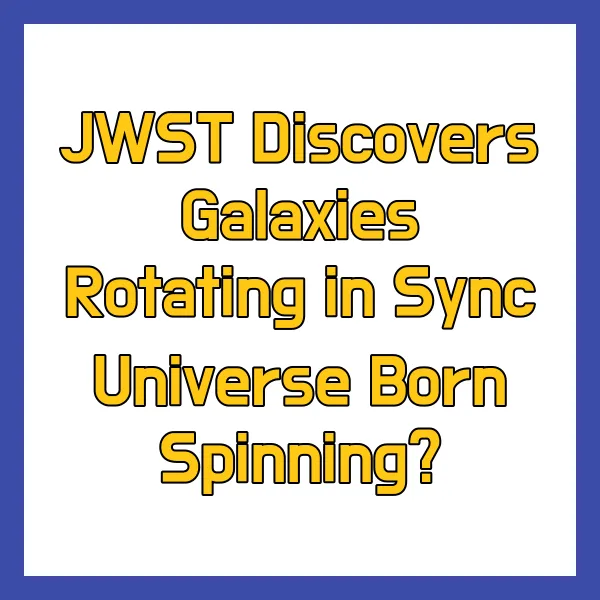
The James Webb Space Telescope (JWST) has unveiled a perplexing cosmic puzzle: a significant number of distant galaxies appear to be rotating in sync, a finding that challenges current cosmological models and raises tantalizing questions about the universe's origins. This surprising discovery, based on observations from the JWST Advanced Deep Extragalactic Survey (JADES), hints at potential underlying mechanisms influencing galactic rotation on a universal scale, including the mind-boggling possibility of a universe born spinning! This discovery, with implications for our understanding of dark matter, cosmic filaments, and even the expansion rate of the universe, has sent ripples of excitement through the scientific community.
The Unexpected Synchronization: A Cosmic Conundrum

The JADES survey, a deep dive into the early universe, provided the data for this groundbreaking study, published in the prestigious Monthly Notices of the Royal Astronomical Society . Researchers meticulously analyzed 263 galaxies, meticulously scrutinizing their rotational directions. What they found was astonishing: a clear bias toward clockwise rotation, with approximately two-thirds of the galaxies exhibiting this directional preference. This 2:1 ratio is far from the expected random distribution, suggesting that something extraordinary is at play!
Visual Confirmation: Seeing is Believing
Remarkably, this rotational asymmetry isn't just a statistical anomaly buried in complex data; it's visually apparent! Even a non-expert, glancing at the JWST images, can discern the surprising prevalence of clockwise-rotating galaxies. This striking visual confirmation adds another layer of intrigue to the findings, making the cosmic puzzle even more compelling.
Unraveling the Mystery: Potential Explanations

The observed rotational bias presents a cosmic enigma, prompting scientists to explore a range of potential explanations, from the revolutionary to the more conventional.
A Universe Born Spinning?!
One breathtaking possibility, albeit a radical departure from current cosmological models, is that the universe itself was born with an inherent spin . This idea, resonating with theories like black hole cosmology, suggests that our universe might exist within a rotating black hole – talk about a mind-blowing concept! If true, this discovery could revolutionize our understanding of the universe's fundamental nature, forcing a complete re-evaluation of existing cosmological frameworks.
The Milky Way's Influence: A Matter of Perspective
A less dramatic, but equally intriguing explanation involves our own galaxy's motion and the Doppler shift effect. As Earth whirls around the Milky Way's center, light from counter-rotating galaxies appears brighter due to the Doppler shift. This could create an observational bias, skewing our perception of galactic rotation in the deep universe. However, this hypothesis would necessitate a significant recalibration of the Milky Way's rotational velocity and its impact on distance measurements, potentially resolving long-standing discrepancies in cosmological models and estimated galaxy ages. Could our own galactic dance be distorting our view of the cosmos?
Cosmic Filaments and Dark Matter: The Universe's Hidden Architects
Beyond these two primary hypotheses, researchers are also investigating the potential influence of large-scale cosmic structures, such as vast filaments of galaxies and the elusive dark matter. Could these structures, the universe's hidden architects, be subtly influencing galactic rotation, perhaps retaining a "memory" of a primordial spin? This avenue of research promises to shed light on the intricate interplay between galactic dynamics and the universe's underlying architecture.
Refining the Picture: Addressing Potential Biases and Future Research

While the JWST data presents compelling evidence, scientists are meticulously investigating potential sources of error and bias. Could there be unforeseen systematic biases in the telescope's instruments or data processing techniques? While rigorous calibration procedures minimize this possibility, it remains a crucial factor to consider. Furthermore, the current sample size, while substantial, might not be fully representative of the entire universe. Expanding the survey to encompass a larger and more diverse sample of galaxies is paramount to confirming and refining these groundbreaking findings. Future deep-field surveys, leveraging the JWST's unparalleled capabilities, will undoubtedly play a pivotal role in unraveling this cosmic mystery.
A Glimpse into the Future: The Unfolding Cosmic Narrative

The discovery of synchronized galactic rotation is not merely a statistical curiosity; it's a profound enigma with far-reaching implications for our understanding of the universe's fundamental properties. As researchers delve deeper into the JWST data and develop sophisticated theoretical models, we can anticipate even more astonishing revelations in the years to come. This discovery underscores the transformative power of the JWST, providing us with an unprecedented glimpse into the deep universe and revealing subtle patterns that were previously hidden from our view. The universe, it seems, is brimming with secrets waiting to be unveiled, and the JWST is poised to illuminate the path forward, one breathtaking discovery at a time. The journey of cosmic exploration has just begun, and the future of astronomy is dazzlingly bright! Who knows what other wonders await us in the vast expanse of the cosmos?
'NEWS > SCIENCE' 카테고리의 다른 글
| Nature Scenes Reduce Pain New Neuroimaging Study (0) | 2025.03.18 |
|---|---|
| Ancient Sunk Seafloor Beneath Pacific Impacts Earth (0) | 2025.03.16 |
| 5-Mile Asteroid Crater Imaged Under Atlantic Ocean (0) | 2025.03.15 |
| Did Earth Have Rings Like Saturn? Ancient Climate Mystery (0) | 2025.03.14 |
| 3.5 Billion-Year-Old Crater Found in Australia (0) | 2025.03.13 |